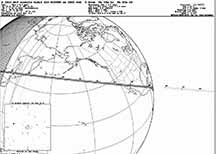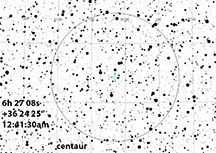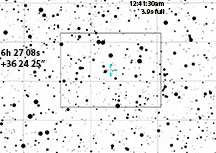


This is a very difficult event. Magnitude of star is given on the IOTA information page below as Mv=14.0, Mr=13.3, but in C2A the APASS "r" magnitude is 13.94, which experience has shown is usually the best match to Watec 910hx magnitudes.
RUWE of the target star is 5.8 which is VERY high. But, C2A says the star is a single star and "clean". So, unknown why the RUWE is so high but indicates the star position is not well pinned down.
Also - this event happens only 10 deg from an 89% gibbous moon and so integrations will be constrained But, given the long duration, it might well be do-able and even a miss will be useful if the rest of the U.S. observers try it too. It's a high value event, so even if low odds. Try from home if it's clear. I might even try it at Cabrillo Observatory if I can get the Watec 910hx to focus at the back end of the 12". Error limits on path are unknown at this time but likely quite wide.
Alt=49 Az=285 Duration = 3.9s with full drop to sky.
 |
 |
 |
Karl could not get it; trees. Kirk did not record - invisible in the bright sky.
I recorded from the bottom of the driveway, but very dim in very bright sky. The view was rather intimidating... the moonlit sky with a r=13.9 star was a very difficult ask. I went back and forth between 8x or 16x, and decided that my experience was that with proper contrast adjust a white-out sky may actually be more recoverable than first believed, and at 16x the target was easier to see. I went with 16x. The sky was bright enough to make OCR'ing difficult in many pieces of the light curve, so I had to use manual time stamps in PyOTE, but no frames were dropped and the manual time stamps worked OK. There was some variable obscuration during the 9 minutes of recording. You'll see on the PyMovie screen capture below there are saturated pixels even in the 'sky', however, that was after adjusting the display contrast, and I don't see the tell-tale signs of saturation in the light curves below. They are just noisy. The Fourier Finder looks to capture the star pretty well and not amid saturated pixels. So, that may be an artifact of how the PyMovie display is handled and not how the actual raw data is processed in PyMovie. Ref2 was the chosen reference star.
A full duration event would send 12 consecutive integrations to ~zero. While there were many individual integrations that dropped that far, none were more than a single integration to zero or below. Odds of a miss were very high, and my noisy data is most consistent with a miss.
|
A gradual obscuration of all stars happened during the event Target light in gold, no-star='sky' in green. |
a 66 frame Fourier finder, with target labelled. Target clearly not with saturated pixels. |
A frame near the start. The contrast adjust used on playback apparently can saturate pixels on this view. But the light curves of the actual readings, at right do not show tell-tale saturation behavior. |
The ref star is in bright green, the target is in blue, empty sky at bottom |
Zoomed in to the predicted event time (which was poorly determined so don't take that location too seriously,, in order to show how long an expected occultation would last and dip. |